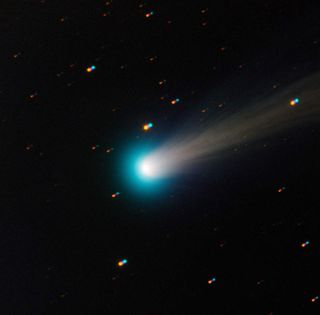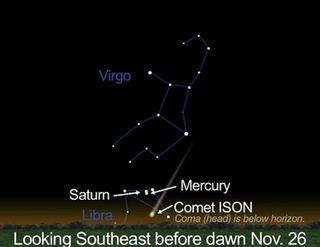Last Chance to See Comet ISON Before Its Thursday Sun Encounter

The early morning of Tuesday, Nov. 26, will be the last chance to spot Comet ISON streaking above the horizon before it makes its Thanksgiving Day slingshot around the sun, according to NASA.
Comet ISON will pass perilously close to the solar surface at a distance of about 730,000 miles (1.2 million kilometers) on Thanksgiving (Nov. 28). The icy wanderer could be ripped apart during this encounter, but if it survives, skywatching experts have said the comet could put on a spectacular show in the weeks ahead, exploding in brightness as it releases dust.
By Tuesday morning, the comet's head will be hidden below the horizon but its tail should be on display, according to NASA experts. Comet ISON can be spotted near the southeast horizon to the right of Saturn and Mercury about an hour before dawn, space agency officials said. [How to See Comet ISON in the Night Sky]

From very dark locations free of light pollution, Comet ISON should be visible to the naked eye early Tuesday, though it will be more clearly visible with binoculars and telescopes. For novice skywatchers who need help finding the planets to guide their eyes to ISON, NASA recommends using a stargazing app. There is also a free app for the iPhone and iPad called Comet Watch that points users in the direction of ISON. You can download it at the iTunes store.
After Comet ISON goes out of view for people on the ground, space telescopes like NASA's SOHO spacecraft will be watching its deciding dive toward the sun. The comet should come back into view near the eastern horizon in the early morning hours of Nov. 29 and/or 30, skywatching experts have said.
Editor's note: If you snap an amazing picture of Comet ISON or any other night sky view that you'd like to share for a possible story or image gallery, send photos, comments and your name and location to managing editor Tariq Malik at spacephotos@space.com.
You can follow the latest Comet ISON news, photos and video on SPACE.com.
Get the Space.com Newsletter
Breaking space news, the latest updates on rocket launches, skywatching events and more!
Follow Megan Gannon on Twitter and Google+. Follow us @SPACEdotcom, Facebook or Google+. Originally published on SPACE.com.
Join our Space Forums to keep talking space on the latest missions, night sky and more! And if you have a news tip, correction or comment, let us know at: community@space.com.

Megan has been writing for Live Science and Space.com since 2012. Her interests range from archaeology to space exploration, and she has a bachelor's degree in English and art history from New York University. Megan spent two years as a reporter on the national desk at NewsCore. She has watched dinosaur auctions, witnessed rocket launches, licked ancient pottery sherds in Cyprus and flown in zero gravity on a Zero Gravity Corp. to follow students sparking weightless fires for science. Follow her on Twitter for her latest project.
Most Popular

